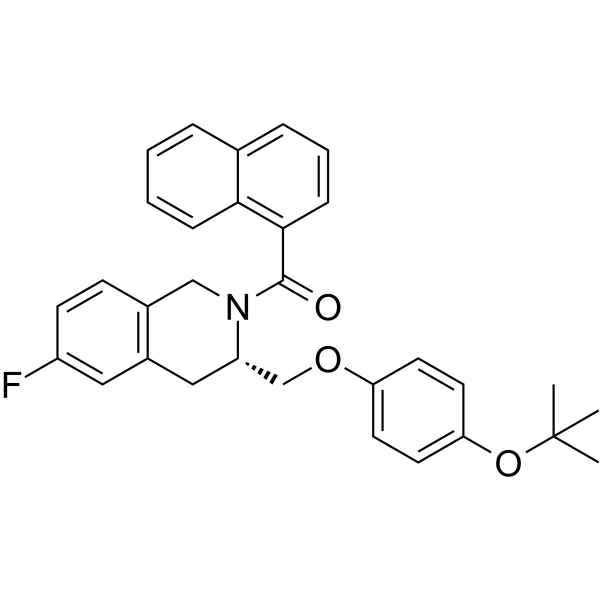| Description |
SR12418 is a REV-ERB-specific synthetic ligand with IC50s of 68 nM and 119 nM for REV-ERBα and REV-ERBβ, respectively. SR12418 can be used in experimental autoimmune encephalomyelitis (EAE) and colitis research[1][2].
|
| Related Catalog |
|
| Target |
IC50: 68 nM (REV-ERBα) and 119 nM (REV-ERBβ)[1]
|
| In Vitro |
SR12418 (5 μM; 96 h) inhibits the growth of TH17 cells[1]. SR12418 (5 and 10 μM; 4 d) inhibits cell differentiation under TH17 polarizing conditions[1]. RT-PCR[1] Cell Line: TH17 cells Concentration: 5 μM Incubation Time: 96 hours Result: Repressed TH17-mediated gene expression and Nfil3. Cell Differentiation Assay[1] Cell Line: Mouse CD4+ T cells Concentration: 5 and 10 μM Incubation Time: 4 days Result: Inhibited TH17 cell differentiation in a dose-dependent manner.
|
| In Vivo |
SR12418 (intraperitoneal injection; 50 mg/kg; twice a day) suppresses the development and severity of experimental autoimmune encephalomyelitis[1]. SR12418 (intraperitoneal injection; 50 mg/kg; twice a day; begin at day 18 post-immunization) shows effects in intervention studies of relapsing-remitting experimental autoimmune encephalomyelitis[1]. Animal Model: C57BL/6 mice inducing experimental autoimmune encephalomyelitis (EAE)[1] Dosage: 50 mg/kg Administration: Intraperitoneal injection; 50 mg/kg; twice a day Result: Diminished the incidence of disease with approximately 20% mice developing disease. Showed no overt signs of toxicity. Animal Model: PLP139-151-induced relapsing-remitting EAE (R-EAE) in SJL/J mice[1] Dosage: 50 mg/kg Administration: Intraperitoneal injection; 50 mg/kg; twice a day; begin at day 18 post-immunization Result: Resulted in a significant reduction in the relapse severity compared to the vehicle control. Showed a significant decrease in the frequency and number of CD4+ and CD8+ effector cells (CD44hi).
|
| References |
[1]. Mohammed Amir, et al. REV-ERBα Regulates TH17 Cell Development and Autoimmunity. Cell Rep. 2018 Dec 26;25(13):3733-3749.e8. [2]. Shuai Wang, et al. Targeting REV-ERBα for therapeutic purposes: promises and challenges. Theranostics. 2020 Mar 4;10(9):4168-4182.
|
